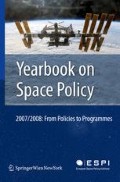Abstract
The international space exploration programme agreed on by 14 space agencies worldwide foresees multiple robotic and human missions in the solar system in the coming decades. In Europe, a major planning effort is ongoing in the framework of ESA’s Exploration Programme (formerly known as “Aurora”) which now envisages the launch of ExoMars in 2016 as a first step towards a robust and renewed exploration effort. Furthermore, a strong heritage exists in Europe within both the mandatory programme under which several solar system missions have been launched, and the various research programmes funded via ELIPS (the European Programme for Life and Physical Sciences and Applications Utilising the International Space Station). This allows Europe and ESA to face new explorative challenges while making use of successful experiences.
Access this chapter
Tax calculation will be finalised at checkout
Purchases are for personal use only
Preview
Unable to display preview. Download preview PDF.
References
European Science Foundation. Humans in Outer Space: Interdisciplinary Odysseys. SCH-ESSC Position Paper. Strasbourg: European Science Foundation, 2008. http://www.esf.org/publications/space.html.
“The Global Exploration Strategy: The Framework for Coordination.” April 2007. ESA 9 Dec. 2008. http://esamultimedia.esa.int/docs/exploration/InternationalCoordination/Global%20_Exploration_Strategy_framework_for_coordination.pdf.
European Science Foundation. Science-Driven Scenario for Space Exploration. ESSC-ESF Position Paper. Strasbourg: European Science Foundation, 2007. http://www.esf.org/publications/space.html.
De Selding, Peter B. “Scientists Urge ESA to Make Station a Priority.” Space News 3 Nov. 2008:11.
Flammarion, Camille. L’Atmosphère: Météorologie Populaire. Paris: Hachette, 1888. 163.
Editor information
Editors and Affiliations
Rights and permissions
Copyright information
© 2009 Springer-Verlag/Wien
About this chapter
Cite this chapter
Worms, JC. (2009). Exploration — How Science Finds Its Way in Europe. In: Schrogl, KU., Mathieu, C., Peter, N. (eds) Yearbook on Space Policy 2007/2008. Yearbook on Space Policy. Springer, Vienna. https://doi.org/10.1007/978-3-211-99091-9_8
Download citation
DOI: https://doi.org/10.1007/978-3-211-99091-9_8
Publisher Name: Springer, Vienna
Print ISBN: 978-3-211-99090-2
Online ISBN: 978-3-211-99091-9
eBook Packages: EngineeringEngineering (R0)

